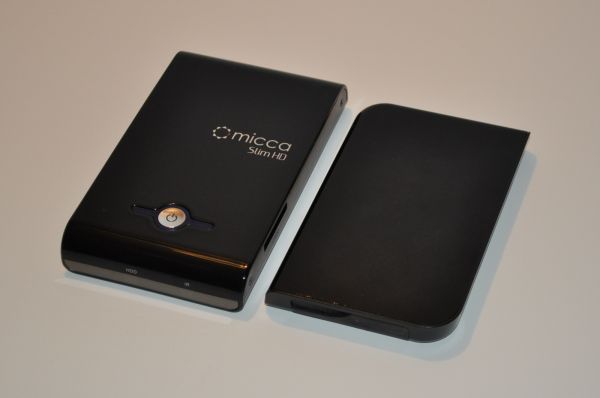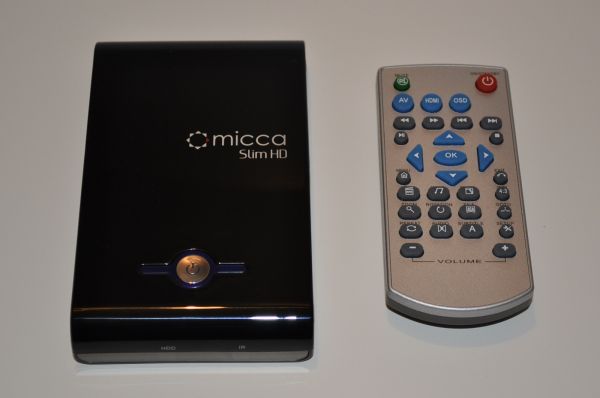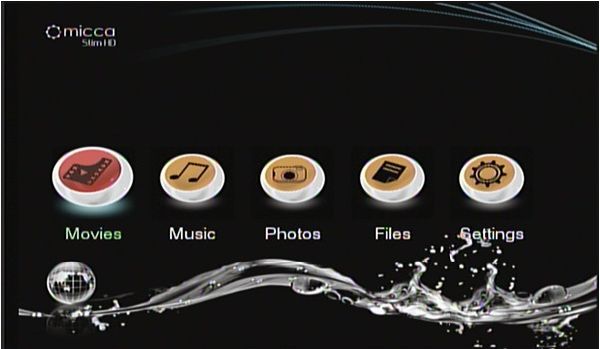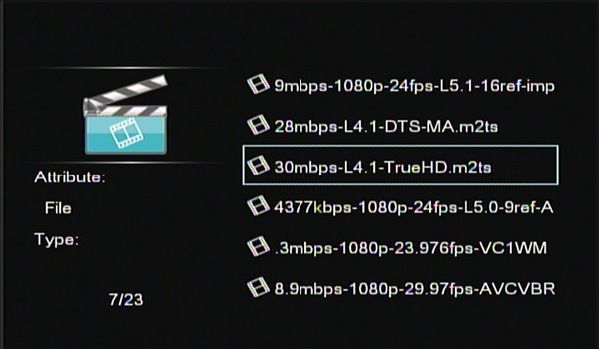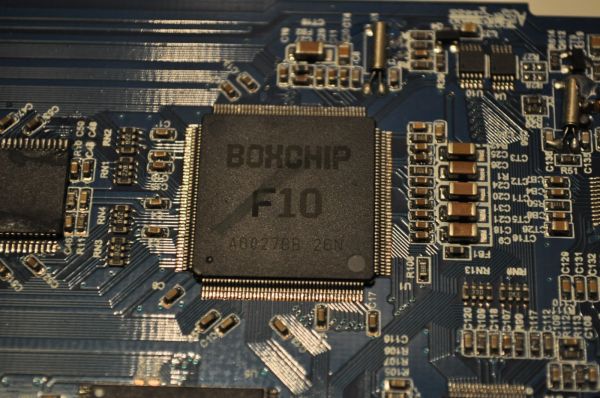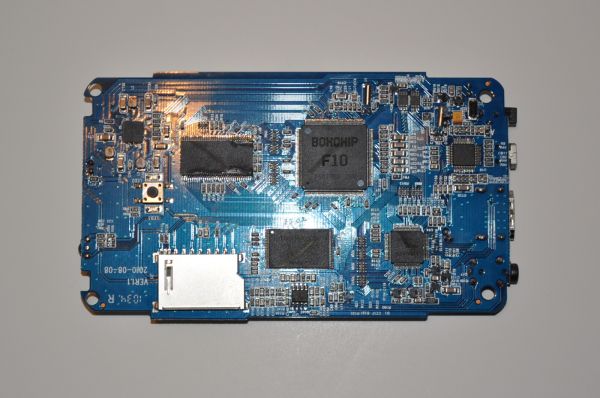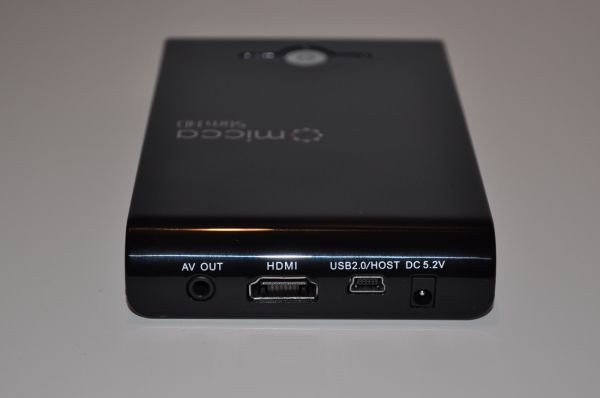
Original Link: https://www.anandtech.com/show/4021/micca-slimhd-1080p-in-your-pocket
Micca Slim-HD: 1080p In Your Pocket
by Vivek Gowri on November 23, 2010 1:40 AM EST- Posted in
- Home Theater
- Micca
- Slim-HD
- Media Player
Last year, Micca released a hard drive based portable media drive called the Slim HDD Digital Media Player (imaginative, I know). Based around a standard 2.5” notebook hard drive, the Slim DMP could handle a wide range of containers and formats and had a 720p HDMI output. At $59 sans drive (now down to $49), it represented a solid value and even without too many premium features, it was a very functional media player at its core. Now we’ve got Micca’s followup device, the Slim-HD Portable 1080p Full-HD Digital Media Player (for the rest of the review, I think I’ll stick to calling it the Slim-HD just for sanity’s sake).
The Slim-HD basically takes the Slim and adds 1080p playback capability, along with support for more video and audio codecs, notably FLAC and DTS. The price is now $79 without drive, and includes a remote, the composite A/V cable, USB cable, and AC adapter. Beyond playing videos, music, and pictures, the Slim-HD doesn’t do a whole lot - no fancy Netlfix playback or internet streaming here like on the WD TV Live Hub we looked at recently. It’s an honest to god media player in the simplest form - just plug it into your TV, navigate to the file you want, and away you go.
As with the original Slim, Micca is aiming for the entry to mid-level market, with a focus on the compact form factor, ease of use, and the ability to use it as a portable USB drive. They don’t intend it to be a high end product, but instead as a portable media drive that can play 1080p content. Does it live up to the goals set for it, or does it fall short of the more fully featured competition?
Micca Slim-HD - In and Around
As I mentioned on the first page, the Slim-HD comes with a few accessories in the box, namely the remote and the various cables needed to run it. Notable in its absence is the HDMI cable; you’ll need to provide your own to get your HD on. We can’t fault Micca for that omission though, since not many competing products include it in the box either.
The media player itself is quite small, at 3.15”(W) x 5.35”(L) x 0.79”(H). It has about the same footprint as most 2.5” portable hard drives, except slightly thicker. Even with the internal 2.5” drive, the Slim-HD is significantly smaller than the WD TV Live models and Seagate’s $100 GoFlex TV, which both exceed 4” x 5” x 1.5”. I’m assuming that the extra size is mostly due to the more power-hungry processors and associated cooling mechanisms (we’ll get to that in a moment), but the takeaway here is that the Slim-HD is significantly smaller than most of the other HD media boxes out there.
Micca Slim-HD (left) next to a WD Passport 2.5" external HDD
The top face has the Micca Slim-HD logo and a power button and LED. The front side contains the HDD activity light and the remote’s IR sensor. The back has a 3.5mm AV out, an HDMI port, a mini-USB port, and a 5.2V DC input. The right side has an SDHC card reader to round out the ports. It’s decent, but nothing to earth shattering. The integrated SD card slot is a nice touch for people who want to take the memory card out of their camera and put onto the TV directly for viewing purposes, a convenience that it seems like many media streamers are overlooking these days.
The remote is small and very light. It’s not terribly different from the remote that WD included with their Live Plus, except with more buttons. Unfortunately, the buttons are pretty haphazardly organized, so it can be somewhat confusing. The remote body feels very light - on more than one occasion I found myself checking whether the batteries were still in the remote. The lightness of the remote and the unintuitive layout make the remote feel somewhat cheap, an impression carried out by the lack of branding and lack of colour coordination between the black unit and the silver remote body. But once you figure out the button placement, it works well enough, so let’s move on.
Micca Slim-HD - User Interface
The UI is another place where the Slim-HD feels cheap. It’s kind of unfortunate, the visual and physical interfaces are both kind of off, which kinda ruins the whole deal. The UI is clean and intuitive, a very straightforward menu system. The home screen is black, with 5 buttons - Videos, Music, Photos, Files, and Settings.
Files and folders are listed by alphabetical order, again just white text on a black background. It’s just a basic, boring, functional UI. Compared to the WDTV Live Hub, the interface lacks polish. I’m not much of a home theater guy, but here’s the kind of difference that I’m talking about: go look at an Android phone, dig down into the settings and menus. Compare it to the same menus in an iPhone or a Windows Phone 7 device. There’s a distinct cohesiveness and style to the iOS and WP7 interfaces that simply isn’t found in Android.
That’s kind of the feeling I get with the Micca UI, except even more so. It’s kind of jarring, it feels like a thrown together UI. It’s just plain, and in comparison to the much more visually jazzed WDTV Live Hub UI, somewhat ugly. If you look at the WDTV screens from our review, you’ll note that it’s basically the same menus, the same options. These aren’t radical UIs, there’s only so many functions for them to serve. But I think providing something more visually engaging than just a plain black screen is really a must, especially for a device that will spend much of its time plugged into large HD displays.
Micca Slim-HD - The Works
The Slim-HD is based around the Boxchip F10, a new for 2010 SoC that’s pretty mysterious, all things considered. It’s based around the SoChip SC9800, which is another high-end PMP media player SoC. You can see a block diagram of the SC9800’s microarchitecture below.

But beyond the SC9800 base, not too much is known about the F10. We don’t have a clockspeed or anything else really - no datasheets to be found, no nothing. We do know that it has full 7.1 downmix capability along with performance roughly on par with the old Realtek 1073 series of SoCs. We expect it to be less powerful than most dedicated media streamer SoCs like the upcoming Realtek 10x5 and current Sigma 864x and 865x lines.
Further analysis of the Slim-HD logic board shows that it has a Samsung 512MB DDR SDRAM chip and a 2GB Hynix NAND chip. There is also an Analogix CoolHD ANX7150 HDMI transmitter, along with a JMicron high-speed USB-SATA bridge to make the connector side of things work.
We should note here that the WD TV Live Plus has the Sigma 8654 media processor inside, but also has a pretty beefy heatsink. Passively cooled, yes, but the Slim-HD does that one better by not having a cooling system. The SoC is just...there. No heatsinks, no vents, and definitely no fans. This was probably done in the interest of portability, and it seems to have paid off for Micca, given the size difference between the Slim-HD and the WD TV. Even without a real cooling mechanism, the Slim-HD is completely stable and doesn't heat up much at all, even during our strenuous test bench, which really points to the low power consumption of the F10 SoC.
Micca Slim-HD - Performance
The Slim-HD has it’s fair share of container and codec support, as listed in the table below. Most of the standard suspects are there, but some of the more interesting (or obscure) things like webm, m2v, and ISO are missing from the spec sheet.
| Micca Slim-HD Digital Media Player | ||||
| Feature | Supported Formats | |||
| 1080p Video | MPEG1, MPEG2, MPEG4-XVID, DIVX, H.264, H.263, WMV9/VC1 | |||
| 720p Video | RMVB | |||
| Video Containers | MKV, AVI, TS/TP, MP4/M4V, MOV, VOB, PMP, RM/RMVB, MPG, M2TS, FLV, WMV | |||
| Audio Codecs | MP3, WMA, OGG, FLAC, APE, AAC, AC3, ATRA, DTS | |||
| Image Files | JPG, JPEG, BMP, GIF, PNG | |||
| Analog Video Outputs | 720x576 (PAL), 720x480 (NTSC) | |||
| Digital Video Outputs | 480p, 720p (50Hz/60Hz), 1080i (50Hz/60Hz), 1080p (50Hz/60Hz) | |||
But when we ran the Slim-HD through our Media Streaming Compatibility Test Suite, we hit some problems. First and foremost, higher framerate 1080p x264 got shafted, especially in the .mkv container. Tons of choppiness, to an unwatchable extent. Add DTS Master Audio, and you end up with a literal slideshow. Weirdly, the problem with DTS-MA also showed up in the 720p test clip. Even trying it two or three times didn’t work too well. The other problem is that while trying to play through those clips, the entire unit would basically go unresponsive to remote inputs (for example, trying to pause it or exit the video and go back to the menu). Let’s just say that the slower processor is coming back to bite the Slim-HD.
As we mentioned before, no ISO support, so the DVD and BD ISO files were goners. Some of the files simply wouldn’t open, even files in common formats supposedly supported by the Slim-HD (note the OGG file [012], the 1080p24 x264 mp4 [010], and a few others). And then some of the more obscure formats that don’t work. We do have to admit that these test streams are meant to put even high end media streamers under stress, and that most of the streams with which the Slim-HD has problems with are not very common. As long as you don't expect everything off the Internet to play, the Slim-HD keeps chugging along.
| Micca Slim-HD: AT Media Streamer Test Suite | |||||||
| File Name | Aspects Tested | Max. Score |
Slim-HD Score |
Notes | |||
| 001-1080p30.x264.AC3.m2ts | H.264, AC3, M2TS |
8
|
8
|
||||
| 002-480i30.MPEG.ASF.dvr-ms | ASF, DVR-MS |
2
|
0 | Format Not Recognized | |||
| 003-1080p24.WMV9.WMAPro.6Ch.wmv | WMV9, WMAPro |
8
|
8 | ||||
| 004-1080p60.x264.8ref.mkv | 60 fps L5.1 H.264 |
8
|
2
|
Very Choppy Playback | |||
| 005-1440x1080i30.SonyAVCHD.m2ts | HD Camcorder Clips |
10
|
10
|
||||
| 006-1080p24.x264.16ref.mkv | L5.1 H.264 |
8
|
0 | File Does Not Play | |||
| 007-1080p.x264.DTS.6Ch.mkv | DTS |
10
|
10
|
||||
| 008-DTS-HRA.8Ch.m2ts | DTS-HRA Bitstreaming |
8
|
8
|
||||
| 009-TrueHD.6Ch..m2ts | TrueHD Bitstreaming |
8
|
8
|
||||
| 010-1080p24.x264.AAC.mp4 | AAC, MP4 |
8
|
0 | File Does Not Play | |||
| 011-FLAC.6Ch.ASS.Subs.mkv | FLAC, ASS Subs |
8
|
4
|
Stylized Subs not displayed | |||
| 012-1080p24.Vorbis.ogg | Vorbis, OGG |
4
|
0
|
File Does Not Play | |||
| 013-352p25RV40.RACook.rmvb | Real Media |
8
|
8
|
||||
| 014-1080i25.AVC.AC3..MPEG-TS.trp | TRP |
2
|
0 | Format Not Recognized | |||
| 015-360p24.XVid.12LanguagesSRT.Subs.mkv | UTF Subs |
8
|
8 | ||||
| 016-1080i30.MPEG2.HeavilyInterlaced.ts | Deinterlacing for MPEG-2 |
8
|
2
|
Flickering Issues | |||
| 017-1080p24.TrueHD.PGS.Subs.mkv | PGS Subs, TrueHD Bitstreaming from MKV |
12
|
8 | No Subtitles | |||
| 018-480p.TVCapture.wtv | WTV |
4
|
0
|
Format Not Recognized | |||
| 019-240p.H264.AAC.m4v | M4V |
8
|
8
|
||||
| 020-1080p30.x264.AC3.m2ts | H.264, AC3, M2TS |
10
|
10 | ||||
| 021-442p30.DivX.AAC.mkv | DivX in MKV Container |
8
|
8
|
||||
| 022-DVDISO.iso | DVD ISO |
10
|
0
|
No ISO Support | |||
| 023-BluRayISO.iso | Blu Ray ISO |
10
|
0 | No ISO Support | |||
| 024-1080p24.x264.DTS-MA.7Ch.mkv | DTS-MA Bitstreaming from MKV |
4
|
0
|
Extremely Choppy Video, No Audio | |||
| 025-720p24.x264.DTS-MA.6Ch.mkv | DTS-MA Bitstreaming from MKV |
4
|
0
|
Extremely Choppy Video, No Audio | |||
| 026-1080p24.VC1.AC3.mkv | VC1 in MKV |
10
|
10
|
||||
| 027-1440x576p25.WVC1.wmv | WVC1 |
8
|
8 |
||||
| 028-720p60.WVC1.WMA3.6Ch.wmv | 60fps WVC1 |
8
|
8 | ||||
| 029-1080p60.AVC.AAC.MP4 | HD Camcorder Clips |
10
|
10
|
||||
| 030-272p.VP6.MP3.FLV | VP6 in FLV, MP3 |
10
|
0
|
File Does Not Play | |||
| 031-854x480p30.H264.AAC.flv | H.264 in FLV |
10
|
10
|
||||
| 032-1080p.VP8.Vorbis.webm | VP8, WebM |
10
|
0
|
Format Not Recognized | |||
| 033-480p24.MPEG1.mpg | MPEG-1 |
4
|
4
|
||||
| 034-1080p24.xvid.avi | HD Xvid, AVI |
10
|
10
|
||||
| 035-672p30.DIVX.MP3.divx | DivX |
10
|
10
|
||||
| 036-720p60.MPEG2.m2v | MPEG-2, M2V |
2
|
0 | Format Not Recognized | |||
| 037-1080p30.MPEG2TS.ts | TS |
2
|
2
|
||||
| 038-1080p25.AVC.AAC.6Ch.MOV.mov | MOV |
10
|
10
|
||||
| 039-1080p24.RV40.Cook.rmvb | HD Real Media |
8
|
8 | ||||
| 040-Anamorphic.MultAud.MultSubs.mkv | Anamorphic, SSA Subs |
10
|
10 |
||||
| 041-1080p24.VC1.DTSHD-MA.m2ts | VC1 in M2TS, DTS-HD Bitstreaming |
6
|
6
|
Only passed DTS | |||
| 042-1080p24.VC1.TrueHD.AC3.m2ts | VC1 in M2TS, TrueHD Bitstreaming |
6
|
6
|
||||
| 043-1080i30.H264.HeavilyInterlaced.ts | Deinterlacing for H264 |
8
|
2
|
Flickering Issues | |||
| 044-1080i30.VC1.HeavilyInterlaced.ts | Deinterlacing for VC1 |
8
|
2
|
Flickering Issues | |||
| Total |
226 out of 336
|
||||||
Overall, the Slim-HD scored 226 out of a possible 336 points, which is 67.25%. That’s pretty good compared to the WD TV Live Plus, which got just 200 (58%), but here’s the rub. The WD TV got really owned in our compatibility suite by the lack of WMV audio and the entire RMVB format. Other than that, it seems that the WD TV might do slightly better with highly compressed 1080p video, but it just doesn’t have the amount of compatibility that the Slim-HD does, and if you’re really into Windows Media or Real Player video formats, the Slim-HD is clearly the way to go.
Micca Slim-HD - Conclusion
And so we arrive at the conclusion. As we said in the conclusion from the WD TV Live Plus, this class of SoC-based media players and streamers lag pretty far behind dedicated HTPCs in both versatility and picture quality. This continues to be true, but we’ll see if that changes when some of the really high end media boxes launch - the Netgear NTV 550, for example. But this portable media drive is quite far from that level.
Micca’s Slim-HD is an interesting proposition. The internal 2.5” drive sets it apart from the Live Plus and the GoFlex, which don’t have internal hard drives but do allow for USB drive connections (as does the Slim-HD, in addition to the internal HDD). The Live Hub is a bit better, but much more costly and does not have the USB host functionality. It’s nice to have your media stored locally, and Micca recognizes that.
Unfortunately, the flip side of this coin is that without a drive or any local media, the Slim-HD is almost useless, while the Live Plus and the GoFlex are both capable as Netflix and Youtube streaming devices. But here’s the most concerning part - both of those are available for less than $100 on the street (Buy.com has the Live Plus for $80), so the price difference is close to negligible. With those, you get a much more polished interface along with the internet streaming capabilities. I’d say that the video compatibility is pretty close - what you gain in absolute versatility with the Slim-HD, you basically give back with the choppiness of the admittedly uncommon high bitrate and frame rate x264 videos.
But really, it all comes down to portability. For the majority of people, I’d say go for one of the media streamers and add a portable USB hard drive. That way you get the HDMI connection and streaming capabilities, along with the portability of your local media (to play off a computer). However, the Micca Slim-HD does nicely fit the bill for people that would like to have a media drive that they can connect via HDMI on the go, which I suppose fulfills its raison d'être. Just don’t expect it to replace your full time HTPC or media streamer and you’ll be happy with it.
Update: Micca has informed us that it will be dropping the price of the Slim-HD to $59.95 on Cyber Monday through the end of the year as a holiday special. This is actually a pretty sweet deal, since it puts the HD only $10 over the price of the regular Slim and really brings price into the equation when compared to the WDTV and the Seagate GoFlex TV. It's a lot easier to recommend the Slim-HD at this reduced price, as it offers an attractive solution for portable 1080p media playback.








